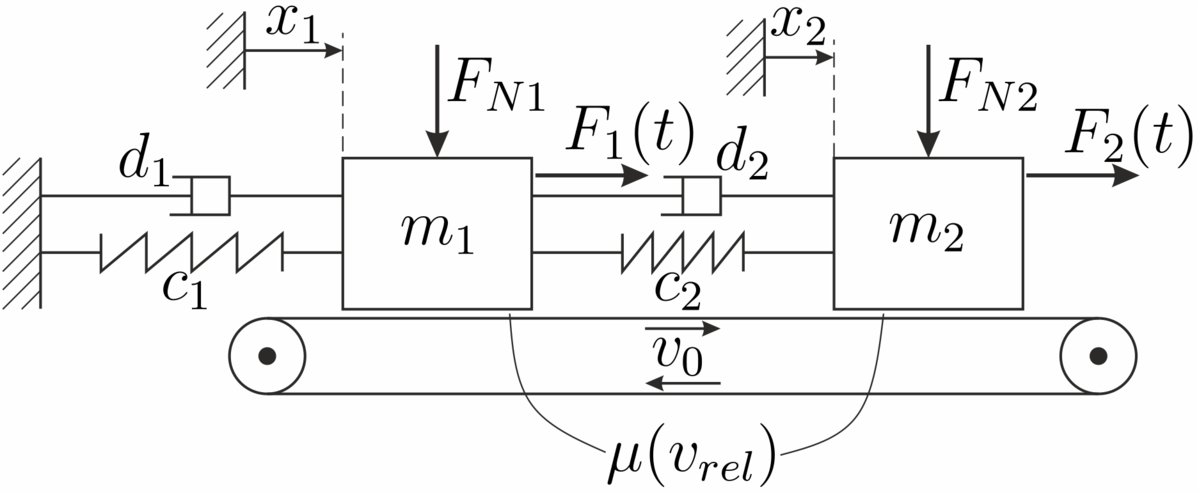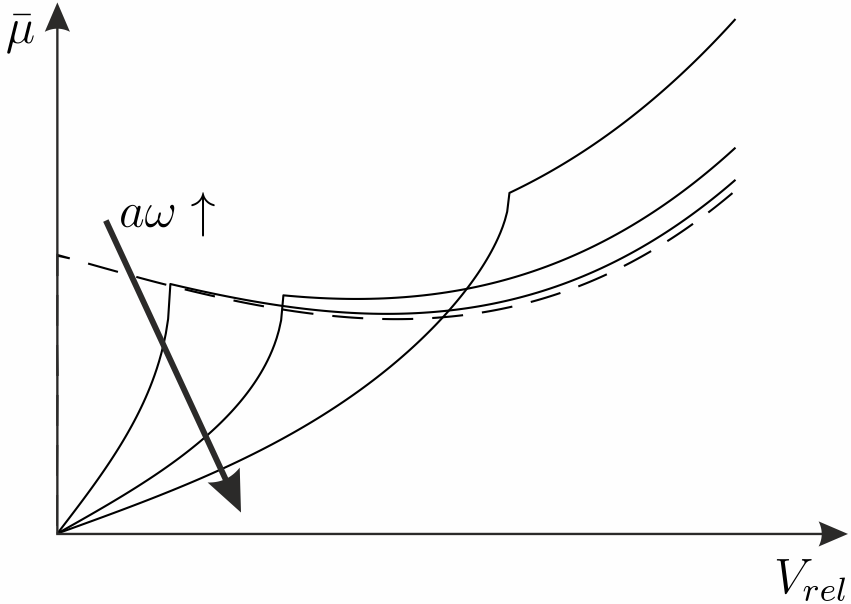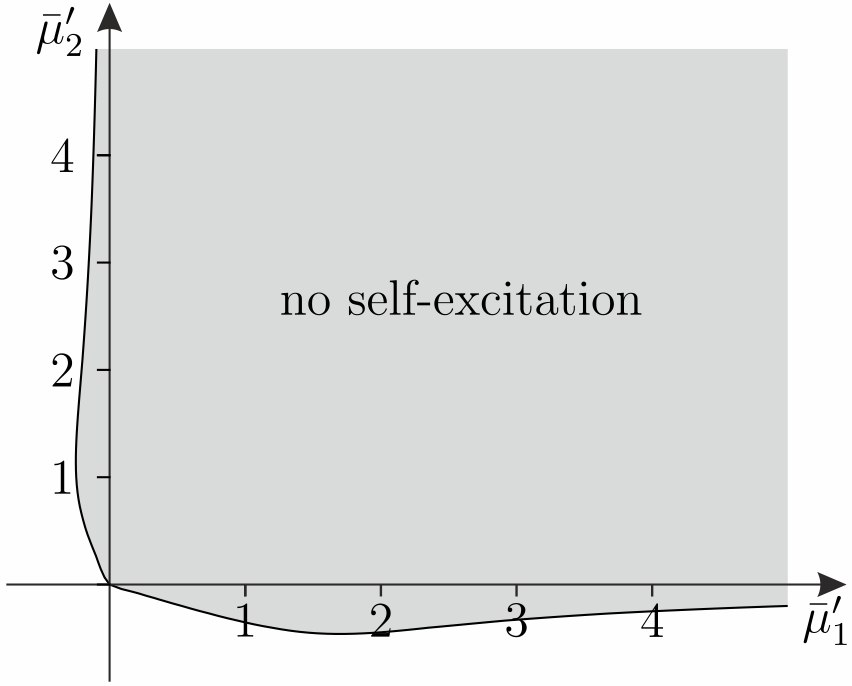
Dr.-Ing. Simon Keller
Postanschrift:
Karlsruher Institut für Technologie
Institut für Technische Mechanik
Teilinstitut Dynamik/Mechatronik
Postfach 6980
76049 KarlsruheHaus- und Lieferanschrift:
KIT-Campus Süd
Institut für Technische Mechanik
Teilinstitut Dynamik/Mechatronik
Geb. 10.23, 2.OG
Kaiserstraße 10
76131 Karlsruhe
Dynamics of Systems with Multiple Friction Contacts
Quenching friction-induced oscillations by the use of high-frequency excitation
Dry friction is present in many technical systems and is the reason for a variety of undesired phenomena. The property of non-smoothness and a negative slope at low relative velocities of the friction force may cause friction induced oscillations or stick-slip motion. One attempt to quench these oscillations are superposed high-frequency vibrations. Thus, the effective friction characteristic is smoothed and undesired friction induced oscillations can be quenched. For systems with one degree of freedom, this method is investigated by simulations and experiments, which show good accordance. Systems with multiple degrees of freedom and multiple friction contacts however show a largely richer dynamic behavior. Also, the influence of high-frequency excitation is not investigated yet. To improve the comprehension of such systems, numerical and analytical approaches are inquired. Applied procedures are the excitation of single masses and investigating the effect on the whole system. Furthermore, the influence of the direction of the excitation and the importance of which masses are excited is examined.
Superposed oscillations in revolutional joints with dry friction
Along with roller bearings, plain bearings are the type of bearings that are used most in technical systems. By the use of different lubricants and pairing materials, the bearings can be adapted to many different requirements. When lubricants are not deployable because of environmental restrictions, dry bearings have to be used. In such systems, undesired effects like stick-slip-motion or break-away can occur due to dry friction. Especially in positioning facilities, where small tolerances and high precision are required, this can be problematic. There are several approaches to compensate effects caused by dry friction and research still goes on. Especially in control technology, many sophisticated concepts are developed to obtain the desired system dynamics.
Another approach to influence the dynamical behavior of the system is the superposition of high-frequency oscillations. These vibrations can be in plane of the contact surface or normal to it. In-plane oscillations can be divided into transversal and longitudinal motion. The superposed oscillations have a smoothing effect on the system dynamics, which can yield a damping effect that can even suppress friction-induced oscillations. This topic has been subject of research in recent years and many papers were published, where theoretical and experimental results are discussed.
To contribute to the understanding and application of this effect, a model of a novel revolution joint with dry friction and axial excitation is built and investigated. A plain bearing rotates around a bolt, which cannot rotate and is excited to axial oscillations. Due to the rotational motion of the bearing, there is permanent sliding in the contact area between plain bearing and the bolt and no such effects like stick-slip-motion or break-away occur. Furthermore, this can lead to a reduction of the torque that is required to realize the rotation of the bearing. However, the friction power leads to a heat input into the bolt which results in thermal expansion and a changed frictional behavior in the contact. To investigate the system dynamics and to analyze the influence of the heat generation, the equation for heat conduction, the equation for the displacement field in the bolt and the equation of motion of the plain bearing have to be evaluated and solved. Numerical simulations show, that a stationary state is reached, where the bolt has a constant, elevated temperature and oscillates at a constant amplitude. The thermal expansion of the bolt results in an increased friction force, which limits the oscillation amplitude. This also results in a greater torque to realize the rotation of the plain bearing. Under certain parameters, this thermal property can even quench the friction reducing effect of superposed vibrations.
To validate this investigation, a test rig is constructed, where an electric motor realizes the rotation and piezo actuators are used for the axial excitation. The drive torque is measured by a sensor and the temperature at the contact area is measured by a pyrometer. The goal is to get insights in the relation between high-frequency excitation, heat generation and the friction torque.
Contact: Prof. A. Fidlin, S. Keller
Publikationsliste
Keller, S.
2025. KIT Scientific Publishing. doi:10.5445/KSP/1000183036
Keller, S.
2025, Mai 30. Karlsruher Institut für Technologie (KIT). doi:10.5445/IR/1000182049
Keller, S.; Fidlin, A.
2024. Forschung im Ingenieurwesen, 88 (1), Artkl. Nr.: 33. doi:10.1007/s10010-024-00753-3
Keller, S.; Fidlin, A.
2024. Proceedings of ITS-IFToMM 2024. Ed.: E. Ciulli, 306–315, Springer Nature Switzerland. doi:10.1007/978-3-031-62616-6_31
Keller, S.; Fidlin, A.
2023. Experimental Mechanics in Engineering and Biomechanics - Proceedings ICEM20. Ed.: J.F. Silva Gomes, Article no: 19958, NEGI-Instituto de Ciência e Inovação em Engenharia Mecânica e Gestão Industrial
Keller, S.; Fidlin, A.
2023. 4. VDI-Fachtagung: Schwingungen 2023, Würzburg, 27th -28th November 2023, 171–184, VDI Verlag. doi:10.51202/9783181024294-171
Keller, S.; Seemann, W.
2022. I. D-A-CH (Hrsg.), Achte IFToMM D-A-CH Konferenz 2022: 24./25. Februar 2022, Online-Konferenz, Universität Duisburg-Essen. doi:10.17185/duepublico/75424
Keller, S.; Seemann, W.
2021. Proceedings in applied mathematics and mechanics, 21 (1), e202100066. doi:10.1002/pamm.202100066
Keller, S.; Seemann, W.
2021. Proceedings in applied mathematics and mechanics, 20 (1), Art.-Nr.: e202000185. doi:10.1002/pamm.202000185
| Titel | Typ | Bearbeiter |
|---|---|---|
| Konzeption und Konstruktion eines Prüfstands zur thermomechanischen Untersuchung von Gleitlagern unter hochfrequenter Anregung | Bachelorarbeit | Robin Schützke |
| Inbetriebnahme eines Tribometers und Entwicklung eines Auswertungstools | Bachelorarbeit | Ozeina Kansoh |
| Parameterstudie zur Unterdrückung reibungserregter Schwingungen mithilfe hochfrequenter Anregung | Masterarbeit | Haichuan Yu |
| Untersuchung ausgewählter Effekte in axial angeregten Drehgelenken mit trockener Reibung | Masterarbeit | Matthias Vogt |
Betreute Lehrveranstaltungen
|
WS 24/25 |
Übungen zu Einführung in die Technische Mechanik II: Dynamik |
| SS 24 |
Workshop 'Arbeitstechniken im Maschinenbau' |
| WS 23/24 | Übungen zu Technische Schwingungslehre |
|
SS 23 |
Übungen zu Mathematische Methoden der Schwingungslehre |
| WS 22/23 | Übungen zu Technische Schwingungslehre |
| SS 22 | Übungen zu Technische Mechanik 4 für mach, tema |
| SS 22 | Engineering Mechanics 4 (Tutorial) |
| WS 21/22 | Übungen zu Technische Schwingungslehre |
| SS 21 | Übungen zu Einführung in die Technische Mechanik I: Statik und Festigkeitslehre |
| WS 20/21 | Übungen zu Dynamik des Kfz-Antriebsstrangs |
| SS 20 | Experimentelle Dynamik |
| SS 20 | Schwingungstechnisches Praktikum |
| WS 19/20 | Übungen zu Technische Mechanik III |
| WS 19/20 | Engineering Mechanics III (Tutorial) |
| SS 19 | Übungen zu Technische Mechanik 4 für mach, tema |
| SS 19 | Engineering Mechanics 4 (Tutorial) |




